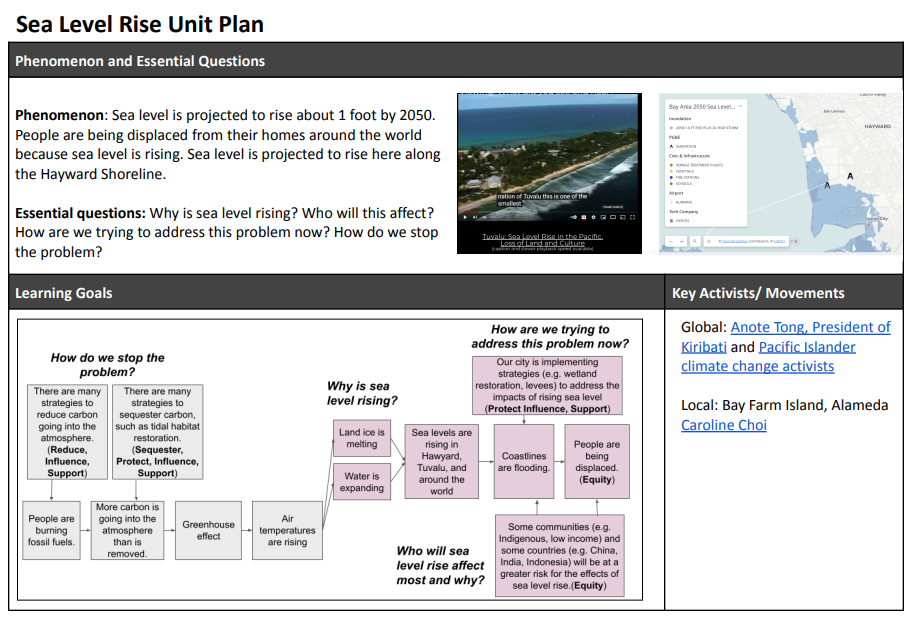Phenomenon Based Lesson Planning
A central principle of CELI pedagogy, which informs our structuring of CELI curriculum, is using real-world phenomena as a starting point to motivate climate learning. A phenomenon is simply something interesting that is happening in the world (NGSS 2024). Our phenomenon-driven approach (stemteachingtools.org 2014), informed by current reform in science education (National Research Council 2012, NGSS Lead States 2013), supports student agency to build knowledge within the classroom, helps students understand the purpose of their learning, and acts as a reference point as learning progresses. Our units are anchored around specific interdisciplinary and justice focused climate phenomena, often centered on heart learning, which provide a purposeful context for subsequent lessons across disciplines. These elements are then integrated into science classes or integrated across the school curriculum involving essentially all subjects, as we have in our CELI middle school.
An Integrated Middle School Unit on Sea Level Rise
At the Cesar Chavez Middle School, we deliver CELI curriculum mostly during discrete ‘blasts’ around particular subject areas throughout the year. During these times almost all teachers in the school teach CELI lessons around a common phenomenon (e.g. Sea Level Rise). Blasts can last 2 - 3 weeks or more as key Heart-Head-Hands learning concepts are scaffolded in, across the curriculum. This following vignette provides an example of how we integrate all of that into a multi-subject unit on sea level rise, starting with a phenomenon presented in English language arts classes of climate refugees from sea level rise.
We chose this particular phenomenon because of its resonance with our particular student population, which includes a disproportionately large population of recent immigrants, many of whom fled crises situations in their home countries. Moreover, many settled in California in the midst of extreme climate crisis as wildfires destroyed entire communities, shut off power, and blackened skies, lungs, and mood for months on end, followed by devastating floods and landslides as atmospheric rivers dumped torrential rains on fire-stripped lands.
The English language arts students start this unit with the heart by sharing what is precious and valuable to them and how it feels if that is taken or stolen. They unpack what the words precious, valuable, taken, and stolen mean and connect to their own lived experiences. They then apply these concepts as they watch a video of the island community of Kiribati being driven from their home by sea level rise. Students wonder: why is sea level rising, who will it impact most and why, is this, or will this, happening in our community, and how do we address the problem? They investigate these questions throughout the rest of the unit across different subject areas.
In science, students use their heads and hands to get to the root of the problem, exploring sea level rise through science labs on thermal expansion, melting ice, and the greenhouse effect. They figure out that increasing carbon in the atmosphere from burning fossil fuels is causing warming air temperatures, which causes land ice to melt, and sea water to expand.
Hands-on and community-engaged action learning continues in PE and social studies. In PE students learn about biking as a climate change mitigation strategy and practice bike safety through a bike ride through their own community. Hands-on climate mitigation learning is returned to in a later blast students build off-grid solar electric systems (Solar Suitcases) used for disaster preparation in the local community. In social studies, students read about local sea level rise adaptation strategies in the City of Hayward’s Climate Action Plan and participate directly in it by planting trees with City officials on Arbor Day.
References:
- National Research Council (2012). A Framework for K-12 Science Education: Practices, Crosscutting Concepts, and Core Ideas. Washington, DC: The National Academies Press. Available online.
- NGSS (2024). Phenomena. Next Generation Science Standards: For states, by states. Washington, DC: National Academies Press. Available online.
- NGSS Lead States (2013). Next Generation Science Standards: For states, by states. Washington, DC: National Academies Press. Available online.
- stemteachingtool.org (2014 -24). Using Phenomena in NGSS-Designed Lessons and Units, Institute for Science and Math Education. Available online.
